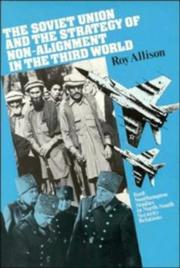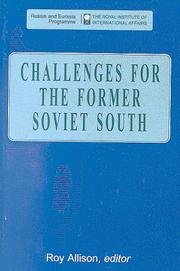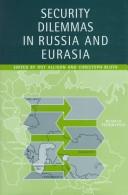| Listing 1 - 10 of 18 | << page >> |
Sort by
|
Book
ISBN: 0333384571 9780333384572 Year: 1985 Volume: vol *8 Publisher: Oxford St. Antony's College
Abstract | Keywords | Export | Availability | Bookmark
 Loading...
Loading...Choose an application
- Reference Manager
- EndNote
- RefWorks (Direct export to RefWorks)
#SBIB:94H6 --- #SBIB:94H9 --- #SBIB:328H26 --- Geschiedenis van Rusland en de landen van de USSR --- Geschiedenis van andere Europese landen --- Instellingen en beleid: USSR (actuele geschiedenis van de USSR: tot 1989) --- Soviet Union --- Finland --- Foreign relations --- Foreign relations with Finland, 1944-1984 --- Foreign relations with Soviet Union, 1944-1984 --- U.S.S.R. Buitenlandse betrekkingen. Finland. 1944-1984. --- Finlande. Relations extérieures. U.R.S.S. 1944-1984. --- U.R.S.S. Relations extérieures. Finlande. 1944-1984. --- Finland. Buitenlandse betrekkingen. U.S.S.R. 1944-1984. --- Finland - Foreign relations - Soviet Union --- Soviet Union - Foreign relations - Finland --- Finland - Foreign relations - 1945 --- -#SBIB:94H6 --- -Soviet Union
Book
ISBN: 9780199590636 9780191756214 Year: 2013 Publisher: Oxford Oxford University Press
Abstract | Keywords | Export | Availability | Bookmark
 Loading...
Loading...Choose an application
- Reference Manager
- EndNote
- RefWorks (Direct export to RefWorks)
This book studies Soviet/Russian attitudes and responses to military interventions, exploring cases from the Gulf War in 1990 to the intervention by Western states in Libya in 2011. It also assesses controversy around Russia’s own interventions in the CIS region. It employs a conceptual framework which compares how Russia and Western powers have viewed the justifications and rationales for such interventions. This is a discursive political process, through which international norms and the evolution of customary international law can be identified. The study also assesses the domestic and international political context to Russian responses to military interventions. Why have there been persistent differences between Russian and Western leaders over Western-led military campaigns and Russia’s own use of force? (Kosovo 1999; Iraq 2003; Georgia 2008; even Libya 2011)? How far was consensus reached exceptionally over the Gulf War in 1990, over intervention in Afghanistan, and the wider use of force in global counter-terrorism? How has Moscow viewed international rule-making overall related to the use of force? The book argues that Russia has remained influential in these debates. Its positions have reflected perspectives on international order and sovereignty, at global, regional, and domestic state levels, as well as a preoccupation with its own international status. This creates challenges for cooperation between Russia and Western states in emerging crises and for Russia’s wider role in international society.
Intervention (International law) --- Intervention (Droit international) --- Russia (Federation) --- Western countries --- Russie --- Occident --- Foreign relations --- Relations extérieures --- Intervention (Droit international)Russia (Federation) --- OccidentForeign relations --- Relations extérieures --- Military intervention --- Diplomacy --- International law --- Neutrality --- West (Western countries) --- Western nations --- Western world --- Developed countries --- Russian Federation --- Rossiyskaya Federatsiya --- Rossiya (Federation) --- Rossii︠a︡ (Federation) --- Российская Федерация --- Rossiĭskai︠a︡ Federat︠s︡ii︠a︡ --- Rosiĭsʹka Federat︠s︡ii︠a︡ --- Російська Федерація --- Federazione della Russia --- Russische Föderation --- RF --- Federation of Russia --- Urysye Federat︠s︡ie --- Pravitelʹstvo Rossii --- Правительство России --- Pravitelʹstvo Rossiĭskoĭ Federat︠s︡ii --- Правительство Российской Федерации --- Правительство РФ --- Pravitelʹstvo RF --- Rosja (Federation) --- Eluosi (Federation) --- O-lo-ssu (Federation) --- 俄罗斯 (Federation) --- Roshia Renpō --- Federazione russa --- OKhU --- Orosyn Kholboony Uls --- Russian S.F.S.R. --- RF (Russian Federation) --- Россия (Federation)

ISBN: 0521355117 0521102502 0511521863 Year: 1988 Publisher: Cambridge : Cambridge University Press,
Abstract | Keywords | Export | Availability | Bookmark
 Loading...
Loading...Choose an application
- Reference Manager
- EndNote
- RefWorks (Direct export to RefWorks)
This study investigates the overall Soviet conception of non-alignment in the Third World and assesses Soviet policy in relation to this issue. The author argues that official Soviet encouragement for the policy of non-alignment and Soviet support for the programme of the Non-Aligned Movement in the 1960s and 1970s have been part of a broad Soviet strategy aimed at weakening and ultimately supplanting Western military and political ties with Third World states. Soviet officials have been reluctant, therefore, to view neutrality, nuetralism or non-alignment as concepts or policies which denote an intermediate status between the blocs. This study assesses the implications of such perceptions for Soviet policy and considers how far Soviet leaders have accepted the independent foreign policy aspirations of non-aligned states.
Nonalignment --- 327 <47> --- Neutralism --- Non-aligned nations --- Non-alignment --- Nonaligned nations --- International relations --- Neutrality --- Developing Countries --- Soviet Union --- -Emerging nations --- Fourth World --- Global South --- LDC's --- Least developed countries --- Less developed countries --- Newly industrialized countries --- Newly industrializing countries --- NICs (Newly industrialized countries) --- Third World --- Underdeveloped areas --- Underdeveloped countries --- Foreign relations --- -Foreign relations --- -Nonalignment. --- Nonalignment. --- -Nonalignment --- Developing countries --- Emerging nations --- Советский Союз --- Ber. ha-M. --- Zwia̦zek Socjalistycznych Republik Radzieckich --- Szovjetunió --- TSRS --- Tarybų Socialistinių Respublikų Sąjunga --- SRSR --- Soi︠u︡z Radi︠a︡nsʹkykh Sot︠s︡ialistychnykh Respublik --- SSSR --- Soi︠u︡z Sovetskikh Sot︠s︡ialisticheskikh Respublik --- UdSSR --- Shūravī --- Ittiḥād-i Jamāhīr-i Ishtirākīyah-i Shūrāʼīyah --- Russia (1923- U.S.S.R.) --- Sovetskiy Soyuz --- Soyuz SSR --- Sovetskiĭ Soi︠u︡z --- Soi︠u︡z SSR --- Uni Sovjet --- Union of Soviet Socialist Republics --- USSR --- SSṚM --- Sovetakan Sotsʻialistakan Ṛespublikaneri Miutʻyun --- SSHM --- Sovetakan Sotsʻialistakan Hanrapetutʻyunneri Miutʻyun --- URSS --- Unión de Repúblicas Socialistas Soviéticas --- Berit ha-Moʻatsot --- Rusyah --- Ittiḥād al-Sūfiyītī --- Rusiyah --- Rusland --- Soṿet-Rusland --- Uni Soviet --- Union soviétique --- Zȯvlȯlt Kholboot Uls --- Związek Radziecki --- ESSD --- Sahaphāp Sōwīat --- KhSHM --- SSR Kavširi --- Russland --- SNTL --- PSRS --- Su-lien --- Sobhieṭ Ẏuniẏana --- FSSR --- Unione Sovietica --- Ittiḥād-i Shūravī --- Soviyat Yūniyan --- Russian S.F.S.R. --- Związek Socjalistycznych Republik Radzieckich --- ZSRR --- Związek Socjalistycznych Republik Sowieckich --- ZSRS --- Social Sciences --- Political Science

ISBN: 081570321X Year: 1996 Publisher: Washington (D.C.): Brookings institution
Abstract | Keywords | Export | Availability | Bookmark
 Loading...
Loading...Choose an application
- Reference Manager
- EndNote
- RefWorks (Direct export to RefWorks)
#SBIB:011.IEB --- #SBIB:328H263 --- Instellingen en beleid: andere GOS-staten --- Asia, Central --- Transcaucasia. --- Transcaucasia --- Haravayin Kovkaz --- I︠U︡zhnyĭ Kavkaz --- Samxretʻ Kavkasia --- South Caucasus --- Transcaucasus --- Zakavkazʹe --- Zakavkazʹye --- Central Asia --- Soviet Central Asia --- Tūrān --- Turkestan --- West Turkestan --- Asia --- History --- -History --- -#SBIB:011.IEB --- Asia, Central. --- Caucasus, South. --- Caucasus, South

ISBN: 1862030162 186203026X 9781862030268 9781862030169 Year: 1997 Publisher: London Royal institute of international affairs
Abstract | Keywords | Export | Availability | Bookmark
 Loading...
Loading...Choose an application
- Reference Manager
- EndNote
- RefWorks (Direct export to RefWorks)
355.02 --- National security --- Conflict management --- Former Soviet republics --- Military policy --- Armed Forces --- Defenses --- National security - Former Soviet republics --- Conflict management - Former Soviet republics --- Former Soviet republics - Military policy --- Former Soviet republics - Armed Forces --- Former Soviet republics - Defenses
Book
ISBN: 9780521355117 9780511521867 9780521102506 Year: 1988 Publisher: Cambridge Cambridge University Press
Abstract | Keywords | Export | Availability | Bookmark
 Loading...
Loading...Choose an application
- Reference Manager
- EndNote
- RefWorks (Direct export to RefWorks)
Book
ISBN: 0191611506 Year: 2013 Publisher: Oxford, England : Oxford University Press,
Abstract | Keywords | Export | Availability | Bookmark
 Loading...
Loading...Choose an application
- Reference Manager
- EndNote
- RefWorks (Direct export to RefWorks)
A detailed and carefully structured study of Soviet/Russian attitudes and responses to military interventions. It explores cases from the Gulf War in 1990 to the intervention led by Western states in Libya in 2011.
Intervention (International law) --- Russia (Federation) --- Western countries --- Foreign relations
Book
Year: 1994 Publisher: Paris: Western European union. Institute for security studies,
Abstract | Keywords | Export | Availability | Bookmark
 Loading...
Loading...Choose an application
- Reference Manager
- EndNote
- RefWorks (Direct export to RefWorks)
Book
ISBN: 033355325X Year: 1992 Publisher: London MacMillan
Abstract | Keywords | Export | Availability | Bookmark
 Loading...
Loading...Choose an application
- Reference Manager
- EndNote
- RefWorks (Direct export to RefWorks)
Book
Year: 1994 Publisher: Paris Union de l'Europe occidentale. Institut d'études de sécurité
Abstract | Keywords | Export | Availability | Bookmark
 Loading...
Loading...Choose an application
- Reference Manager
- EndNote
- RefWorks (Direct export to RefWorks)
| Listing 1 - 10 of 18 | << page >> |
Sort by
|

 Search
Search Feedback
Feedback About UniCat
About UniCat  Help
Help News
News